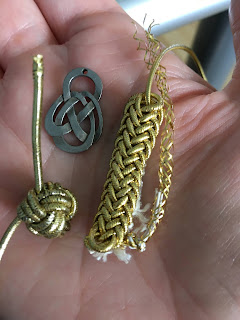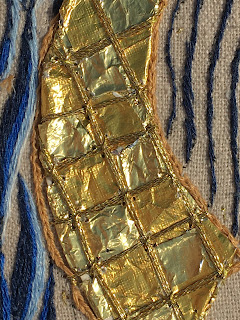I think it’s really interesting to note when Opus Anglicanum was copied in other countries and later times, they could never quite manage it. For instance in later examples French ‘purses‘ with secular subject matter, you can clearly see very dark gaps between lines of stitches and in the stitches too. The only later examples of split stitch faces that seem to reinvent the style with stunning results is Dutch pieces, but they have had the benefit of the renaissance and its advances in our understanding of modelling.
To turn my earlier phrase around ‘what you can draw, you can sew’, as far as the Dutch work goes, and I think German examples too, they are such fine pieces ‘you can draw what has been sewn’, kind of thing.
So ok, what about my own investigations.
So far I’ve come up with three try outs that I’m happy with, two strips and one circle. I’ve done about 50 so far. I’ve got patience for this kind of thing because basically we’re trying to unravel really big ecclesiastical secrets, remember, at all times, they worked never to be copied, call them trade secrets...(for big trade).
Now in one of them, I noticed something ‘happened’, some kind of geometric quirk emerged, but I was under pressure and the phone kept ringing, so I’ll have to do them all again and hopefully the ‘thing’ will happen again.
Because, you certainly cannot write down what you haven’t understood and you certainly couldn’t explain it to another...
So, this example, I took a much longer back stitch and then went into it, from the front, as a base stitch three times. So what you ‘see’ are evenly spaced small stitches but underneath, is quite a thick substrate of longer stitches. I found this way of working produced a flatter surface. For the return row, it took me back to something I worked out a couple of years back, when I noticed the difference outline and stem stitch made to the twist of the thread. Still working on the return row conundrum...
I don’t think they under stitched the work as I first suspected.
But I’m certain they stitched over two layers of fabric, linen then silk.
The silk fabric is directly under the stitches and it’s grain runs vertically, behind the surface of the work (and reminded me of Soumak weaving). I’m still working out whether they pierced the linen for the very fine split stitch work, because especially on the faces, the stitches are incredibly fine, if not incredibly small.
The stitches on the faces are worked with very fine thread, in tight rows, going back and forth or up and down. The return row is not as regular as the first row, sometimes a lot finer. I have wondered if the return row is sometimes stem stitch? I’m still working on that idea. (Let’s not forget, a row of outline, followed by a row of stem, creates the illusion of an incredibly fine chain?)
The other thing about stem stitch is, it can be used to tidy up a curve...I’ll try both ways, photograph it and place it side by side with the historical image. That’s all I do, is aim for a replica.
Some split stitches on the outer areas are quite chunky. What you do notice the more you stare at these things, is that the silk for the faces was incredibly fine.
My personal view at this stage is, to create ‘body‘ with split stitch, you really need to work it as a back stitch. This means that it follows there is more thread at the back of the work, but it also means the stitch itself is stronger, thereby more durable? Especially for items that were in constant use??
Let’s keep in mind that the strongest stitch you can make with hand stitching is a back stitch. In fact machine sewing uses the back stitch as it’s basis of mechanical design.
Here’s an interesting figure, notice the pre-renaissance modelling of his forehead. If you were wanting to stitch his forehead, you might make circles for forehead lumps....know what a I mean?
So here are the two main figures from the piece I’m looking at:
Ok, so I’ve made quick ‘road maps‘ of where I can see lines of stitching.
There is clearly a bullet proof formula going on here for the treatment of (male) faces. The mouths, ears and hair are so unique.
Each of the figures is also not clean shaven, there is stubble, if you look really hard.
I cannot wait to make the mouths! If you think about it, lips are so incredibly difficult to sew. But their tried and tested formula gave consistent results every time. Their gaze is mostly averted, I’ve only seen a Seraphim look directly at the viewer.
The other thing to share at this point is, these faces are larger than I first thought and so there is hope for mere mortals to replicate them. Ah that would be a fine thing...
I’ve come to realise that what held me back before in completing things was where they would end up. I was never a canvas artist, but a paper one. Don’t give me a blank wall, but give me a book any day....! So I’ve decided to make things ‘I want’ and put them in a needlework book. This page will be for 1300s.
Gotta go ppl, the day job awaits me...







































































